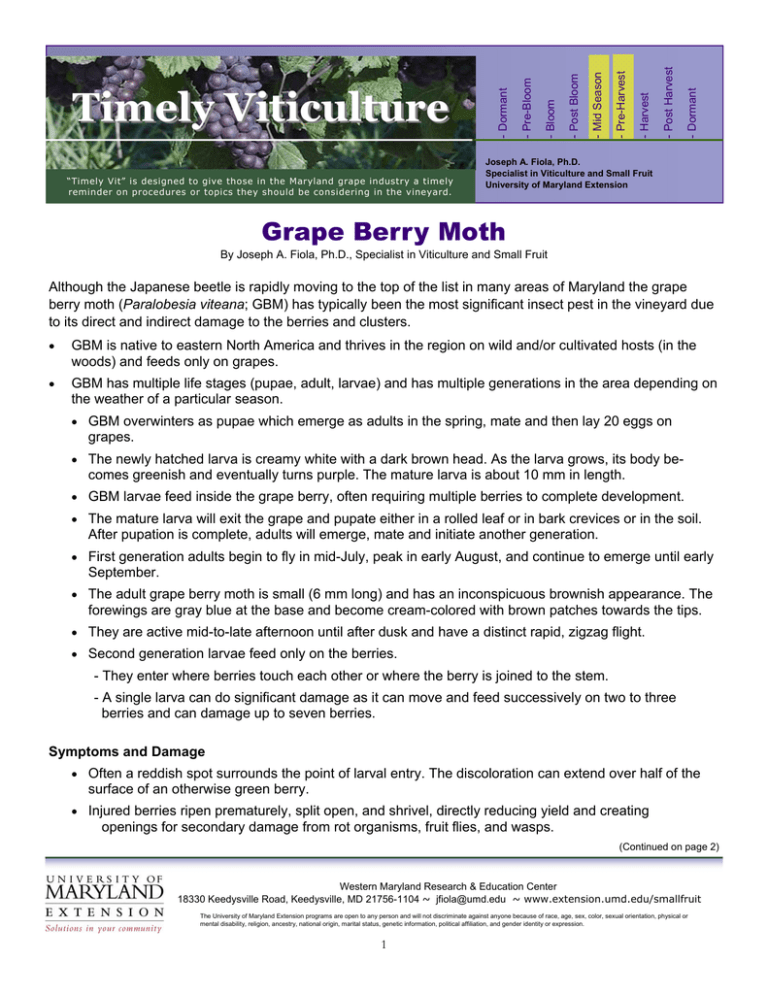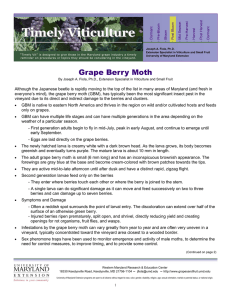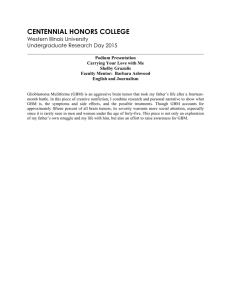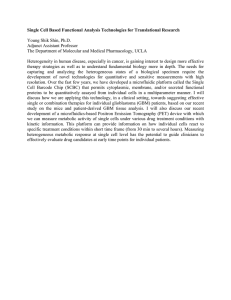Timely Viticulture
advertisement

“Timely Vit” is designed to give those in the Maryland grape industry a timely reminder on procedures or topics they should be considering in the vineyard. - Dormant - Post Harvest - Harvest - Pre-Harvest - Mid Season - Post Bloom - Bloom - Pre-Bloom - Dormant Timely Viticulture Joseph A. Fiola, Ph.D. Specialist in Viticulture and Small Fruit University of Maryland Extension Grape Berry Moth By Joseph A. Fiola, Ph.D., Specialist in Viticulture and Small Fruit Although the Japanese beetle is rapidly moving to the top of the list in many areas of Maryland the grape berry moth (Paralobesia viteana; GBM) has typically been the most significant insect pest in the vineyard due to its direct and indirect damage to the berries and clusters. GBM is native to eastern North America and thrives in the region on wild and/or cultivated hosts (in the woods) and feeds only on grapes. GBM has multiple life stages (pupae, adult, larvae) and has multiple generations in the area depending on the weather of a particular season. GBM overwinters as pupae which emerge as adults in the spring, mate and then lay 20 eggs on grapes. The newly hatched larva is creamy white with a dark brown head. As the larva grows, its body be- comes greenish and eventually turns purple. The mature larva is about 10 mm in length. GBM larvae feed inside the grape berry, often requiring multiple berries to complete development. The mature larva will exit the grape and pupate either in a rolled leaf or in bark crevices or in the soil. After pupation is complete, adults will emerge, mate and initiate another generation. First generation adults begin to fly in mid-July, peak in early August, and continue to emerge until early September. The adult grape berry moth is small (6 mm long) and has an inconspicuous brownish appearance. The forewings are gray blue at the base and become cream-colored with brown patches towards the tips. They are active mid-to-late afternoon until after dusk and have a distinct rapid, zigzag flight. Second generation larvae feed only on the berries. - They enter where berries touch each other or where the berry is joined to the stem. - A single larva can do significant damage as it can move and feed successively on two to three berries and can damage up to seven berries. Symptoms and Damage Often a reddish spot surrounds the point of larval entry. The discoloration can extend over half of the surface of an otherwise green berry. Injured berries ripen prematurely, split open, and shrivel, directly reducing yield and creating openings for secondary damage from rot organisms, fruit flies, and wasps. (Continued on page 2) Western Maryland Research & Education Center 18330 Keedysville Road, Keedysville, MD 21756-1104 ~ jfiola@umd.edu ~ www.extension.umd.edu/smallfruit The University of Maryland Extension programs are open to any person and will not discriminate against anyone because of race, age, sex, color, sexual orientation, physical or mental disability, religion, ancestry, national origin, marital status, genetic information, political affiliation, and gender identity or expression. 1 Timely Viticulture Grape Berry Moth continued from page 1 Mid-Season Thru Pre-Harvest Monitoring Infestations by the grape berry moth can vary greatly from year to year and are often very uneven in a vineyard, typically concentrated toward the vineyard area closest to a wooded border. Sex pheromone traps have been used to monitor emergence and activity of male moths but have been limited in helping to determine the need and timing for control measures. Effective control of GBM requires precise information about the timing of egg laying and larval development. A degree day model has been developed (Dr. Mike Saunders, PSU) to help to predict the various stages. Egg laying is well synchronized with the earlier bloom of native wild grapes so the date of wild grape bloom is a useful predictor for GBM emergence. A continuing total of degree days is maintained to identify when each generation is predicted to be laying eggs: the first generation at 810 degree days, the second generation at 1620 degree days, and in early warm seasons, possibly a third generation at 2430 degree days. GBM’s synchronization with wild grape bloom means that most first-generation eggs are laid on wild grapes, rather than cultivated grapes, therefore no treatment is recommend for this first generation. First generation adults begin to fly in early July, peak in early August, and continue to emerge until early September. Efforts directed at chemical control of GBM should be targeted at the second and subsequent egg laying periods of GBM. To monitor for presence and damage, look for the reddish/purplish spots on the green fruit and webbing. The threshold for treatment is about 6% damaged clusters. Control (Consult the commercial pest control recommendations; and always READ THE LABEL! To control light infestations, injured berries can be removed by hand. Control aimed at eggs and early hatched larvae are very effective. Intrepid, Altacor, and Belt are excellent options for these early egg laying timings. Applied directly to clusters only, these three products have long residual activity, are relatively rainfast, have low impact on beneficials, and good worker safety. Dipel and Biobit, (Bacillis thuringiensis – BT), narrow spectrum treatments, are also an option. Delegate and Entrust are softer compounds derived from soil microbes (Entrust is OMRI approved/registered for organic applications). They are also labeled for Spotted Winged Drosophila. Where the grape berry moth is an annual problem, mid-season sprays (July-August) with insecticides such as the pyrethroids (Danitol, Baythroid, Mustang MAX) or Sevin or Imidan may be necessary if the problem is severe. You can find the Cornell Fact Sheet on GBM at: http://www.nysipm.cornell.edu/factsheets/grapes/pests/gbm/gbm.asp Virginia Tech has some good information and links at: http://www.virginiafruit.ento.vt.edu/GBM.html 062013 Western Maryland Research & Education Center 18330 Keedysville Road, Keedysville, MD 21756-1104 ~ jfiola@umd.edu ~ www.extension.umd.edu/smallfruit The University of Maryland Extension programs are open to any person and will not discriminate against anyone because of race, age, sex, color, sexual orientation, physical or mental disability, religion, ancestry, national origin, marital status, genetic information, political affiliation, and gender identity or expression. 2




